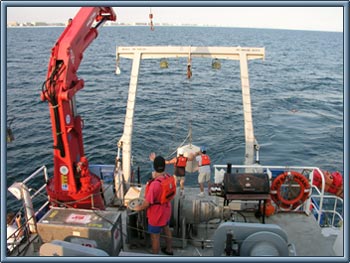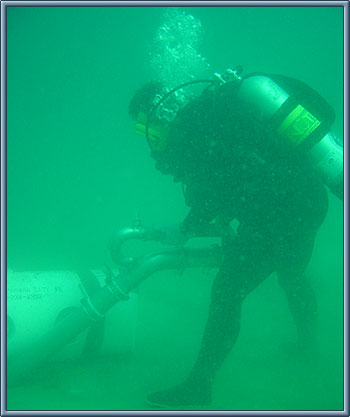
|
|

Eric Thorsos
Principal Physicist
Ocean Acoustics Dept.
Applied Physics Laboratory
University of Washington
Kevin Williams
Principal Physicist
Ocean Acoustics Dept.
Applied Physics Laboratory
University of Washington
DJ Tang
Senior Oceanographer
Ocean Acoustics Dept.
Applied Physics Laboratory
University of Washington
Steve Kargl
Senior Physicist
CIMU
Applied Physics Laboratory
University of Washington
Office of Naval Research
CDR Robert Headrick, Code 321OA
Ellen S. Livingston, Code 321OA
Nicholas P. Chotiros, Code 321OA
Kerry W. Commander, Code 321MS
Douglas A. Abraham, Code 321US
The overall objective of SAX04 is to better understand the acoustic detection at low grazing angles of objects, such as mines, buried in sandy marine sediments. One component of the SAX04 work is designed to collect data and gain a greater understanding of high-frequency sound penetration into, propagation within, and scattering from the shallow water seafloor at a basic research level. A second component is designed to provide data directly on acoustic detections of buried mine-like objects at low grazing angles.
|
Previous work has shown that sound penetration into sandy sediments at low grazing angles is greatly enhanced when ripples are present on the seafloor. This has led to the companion Ripples DRI Experiment. The goal of this work is to better understand the growth, evolution, and decay of ripples on sandy seafloors at shallow water sites. The experiment site for SAX04 is about 1 km offshore in water about 17 m (55 ft) deep south of Fort Walton Beach, Florida. The smaller town of West Destin, Florida, stretches along the beach just south of Fort Walton Beach and the experiment site is just to the south of West Destin. A set of mine-like targets were buried at the experiment site in early May 2004. They were contained within a 60 m by 60 m region, bounded by 30 deg 23.221 min N, 30 deg 23.189 min N, 86 deg 38.660 min W, and 86 deg 38.622 min W. (See the Chirp Sonar Survey, May 2004 for a discussion of the target field site selection.) The SAX04 work extended about 100 m south of the target field, and about 200 m north, east, and west of the target field. Much of the Ripples DRI work was done within the SAX04 area just defined, but some was done outside of it. Instrumentation was deployed for examining ripple evolution in a wider region, including closer to shore. The experimental work began in early September 2004 and extended to the middle of November.
|


